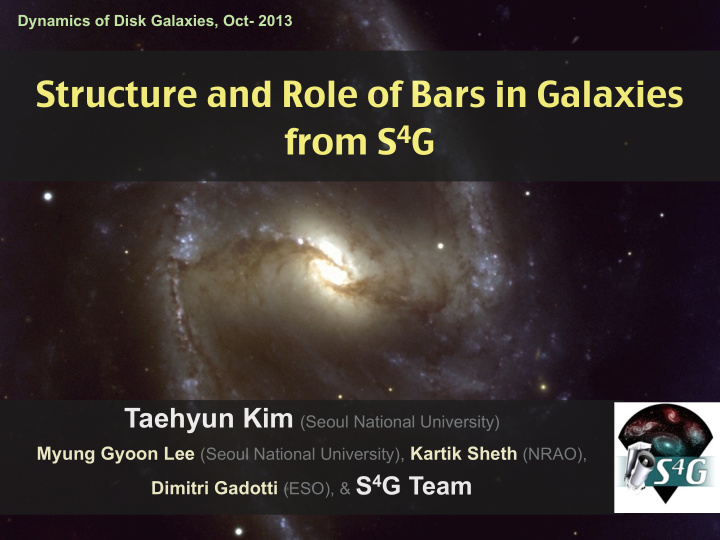



Dynamics of Disk Galaxies, Oct- 2013 Structure and Role of Bars in Galaxies from S 4 G Taehyun Kim (Seoul National University) Myung Gyoon Lee (Seoul National University) , Kartik Sheth (NRAO), Dimitri Gadotti (ESO), & S 4 G Team
Light profile of bars NGC 925 NGC 1300 Hubble Heritage Team Mt. Lemmon SkyCenter Elmegreen & Elmegreen (1985), Elmegreen+(1996), ~30 Galaxies Flat surface brightness profile Exponential -like profile 흁 (r) 흁 (r) r r
Light profile of bars NGC 925 NGC 1300 Hubble Heritage Team Mt. Lemmon SkyCenter Elmegreen & Elmegreen (1985), Elmegreen+(1996), ~30 Galaxies Bars become flat as stars trapped around x1 orbit (Athanassoula 2003) - Locations of resonances (ILRs), resonance crowding (Combes & Elmegreen 1993; Elmegreen et al. 1996) Quantifying bar profile to investigate evolution of bars
Shape of bars NGC 925 NGC 4314 LMC SDSS ESO Mt. Lemmon SkyCenter Bars are rectangular-shaped (Athanassoula 1990, Gadotti 2011) Are bar shapes different ? Is there any disky bar? Can these tell us about how bars formed?
Data The S pitzer S urvey of S tellar S tructure in G alaxies ( S 4 G , Sheth et al. 2010) - Survey of ~ 2,352 galaxies in 3.6 & 4.5 µm 3.6 μ m B NGC 7552
Data Analysis 2D decomposition - 144 SB0~SBdm nearby barred galaxies BUDDA ( Bu lge/ D isk D ecomposition A nalysis, de Souza+2004, Gadotti 2008 ) NGC 936 Bulge Disk Bar Model Residual Disk breaks are taken into account in our disk model fits • Disk scale length, Bar/Total, and Bulge/Total, Bar profiles are affected
Light profile of bars ? 흁 (r) r Sersic Profile (1963)
Light profile of bars classical bulge pseudo bulge bulgeless Bar profiles are related to the presence/prominence of a bulge. - Galaxies with a bulge have flat bars - Bulgeless galaxies have both flat and exponential bars.
Interpretation • Bar profile may be an age indicator of the bar • Older bars should be flatter - longer time to trap stars into bar orbits • Consistent with the COSMOS study (Sheth et al. 2008) - more massive, redder, and bulge dominated disks formed bars first (downsizing) • Need to better understand conditions that turn a exponential profile into a flat profile - What properties of the bar, disk, and galaxy make this process most efficient? (Gas? Triaxial halo? Athanassoula et al. 2013)
Outer shape of bars Generalized ellipses (Athanassoula et al. 1990) c: shape parameter c<2 : Disky c=2 : Ellipse c>2 : Boxy ϵ =0.65 Di fg erent shapes of bar models
Bars are boxy! bulgeless pseudo bulge Intermediate bulge classical bulge c: shape parameter Kim et al. (2013b, in prep) No significant differences in the shape of bars Bars changes in profile while keeping their outer shapes boxy
Role of Bars - Induce disk break Final profile : double exponential Bars induce angular momentum redistribution Initial profile: => results in disk break exponential (Debattista et al. 2006) How are breaks related to bars? Where do breaks happen?
Disk break (Muñoz-Mateos et al. 2013) r br : break radius R bar : deprojected bar radius Kim et al. (2013a, submitted) Galaxies with B/T> 0.1 : r br /R bar ~2, related to bar OLR (Schwarz 1981; Buta & Crocker 1991; Buta 1995) Galaxies with B/T< 0.1 : resonances may be coupled with spirals, (Muñoz-Mateos et al. 2013) r br may be star formation threshold related. (Kennicutt et al. 1989, Elmegreen et al. 2006)
Where do breaks arise? Type II Disks with an outer ring NGC 1326 r OR : outer ring radii from Comerón et al. (2013, submitted) r br : break radii 86% of outer rings are in between Kim et al. (2013a, submitted) 0.8 × r br and 1.2 × r br Disk breaks are at outer rings (~OLR of bars)
Summary Radial profile of bars are related to the presence of the bulge. - consistent with the COSMOS study (downsizing) Bar profiles change with bulge properties (rotation curve, disk dynamics) while keeping their outermost shape boxy . Most disk breaks arise at the outer ring. - bar plays a role in setting the position of break.
Thank you!
Recommend
More recommend